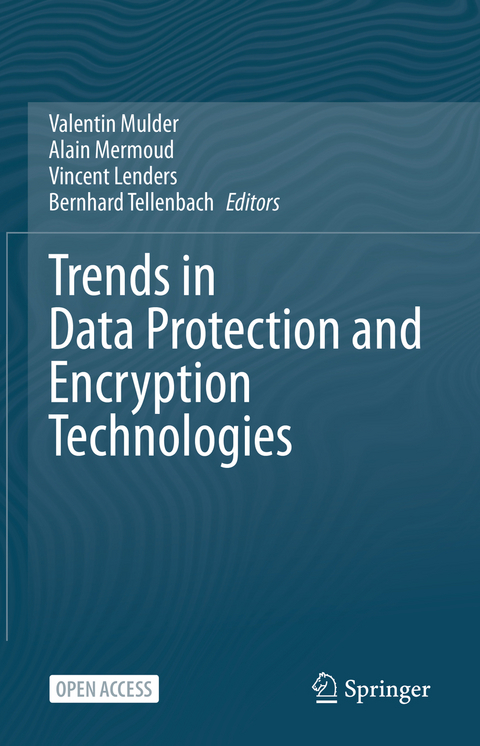
Trends in Data Protection and Encryption Technologies
Springer International Publishing (Verlag)
978-3-031-33385-9 (ISBN)
Fifty experts from academia, government, and industry have contributed to this study and provided their viewpoints on the different technologies and trends. This comprehensive collection of factsheets provides a reference for organizations and individuals that need to elaborate coherent and efficient data protection and encryption strategies in the coming years. The 38 technologies have been sorted into five categories. First, encryption foundations represent the technologies used to create other encryption applications. Second, low-level applications represent the technologies that focus on micro functionalities. Third, high-level applications represent the technologies that focus on more abstract and macro functionalities. Fourth, data protection represents the technologies used to protect data without encrypting these data. Finally, use cases represent concrete ways the different technologies can be used together to create a working solution.
The book serves as a guide for decision-making within administrations, government organizations, and industry. It will also be interesting for the tech-savvy board member or engineers looking to get an entry point into data protection topics. Last not least, the book will also be a valuable reading for anyone interested in data protection and encryption.
lt;b> Alain Mermoud is the Head of the Technology Monitoring team at the armasuisse Cyber-Defence Campus (Switzerland). He obtained his PhD (2019) in Information Systems from HEC Lausanne. His main research interests are emerging technologies, disruptive innovations, cyber threat intelligence, and the economics of cyber security.
Valentin Mulder is a study coordinator at the Cyber-Defence Campus at armasuisse. He holds a Master (2022) degree in Legal Issues, Crime, and Security of Information Technologies from the University of Lausanne. Before his current position, he worked in the banking industry, particularly in the area of online fraud.
Vincent Lenders is the founding Director of the armasuisse Cyber-Defence Campus. He holds a Master (2001) and PhD (2006) degree in electrical engineering and information technologies from ETH Zurich. He has contributed to developing and implementing various national cyber strategies at the Swiss Government and has published more than 150 technical papers on cyber security, data science and networking.
Bernhard Tellenbach is the Head of the Cyber Security team at the armasuisse Cyber-Defence Campus. He holds a Master (2005) and PhD (2012) degree in electrical engineering and information technologies from ETH Zurich. Before his current role, he led the information security research group at Zurich University of Applied Sciences. In addition, Bernhard leads the Swiss Cyber Storm association.
- Part I Encryption Foundations. - 1. One-Time Pad. - 2. Symmetric Cryptography. - 3. Asymmetric Encryption. - 4. Key Management. - 5. Hash Functions. - 6. Zero-Knowledge Proof. - 7. Random Number Generator. - 8. Homomorphic Encryption. - 9. Quantum Key Distribution. - 10. Post-quantum Cryptography. - Part II Low-Level Applications. - 11. Functional Encryption. - 12. Identity-Based Cryptography. - 13. Multi-Party Threshold Cryptography. - 14. Searchable Symmetric Encryption. - 15. Digital Signature. - 16. Hardware Security Module. - 17. Secure Multi-Party Computation. - Part III High-Level Applications. - 18. Trusted Execution Environment. - 19. Confidential Computing. - 20. Hardware Acceleration. - 21. Secure Operating System. - 22. Biometrics. - 23. Electronic Voting. - 24. Data in Transit Security. - 25. Blockchain. - 26. Tunneling and VPN. - Part IV Data Protection. - 27. Differential Privacy. - 28. Digital Rights Management. - 29. Authentication. - Part V Use-Cases. - 30. Secure Media. - 31. Secure Positioning and Localization. - 32. Secure Payment. - 33. Disk, File and Database Encryption. - 34. WEB3. - 35. 5G. - 36. Email Security. - 37. Secure Messaging. - 38. Secure Smartphone. - Part VI Analysis and Conclusion. - 39. Scientometric and Wikipedia Pageview Analysis. - 40. Trends in Open Source Software for Data Protection and Encryption Technologies. - 41. Conclusion.
| Erscheinungsdatum | 02.08.2023 |
|---|---|
| Zusatzinfo | XIX, 262 p. 1 illus. |
| Verlagsort | Cham |
| Sprache | englisch |
| Maße | 155 x 235 mm |
| Gewicht | 583 g |
| Themenwelt | Informatik ► Netzwerke ► Sicherheit / Firewall |
| Schlagworte | authentication • Blockchain • Cyber-defence • data protection • Digital rights management • Encryption • open access • trusted execution |
| ISBN-10 | 3-031-33385-3 / 3031333853 |
| ISBN-13 | 978-3-031-33385-9 / 9783031333859 |
| Zustand | Neuware |
| Haben Sie eine Frage zum Produkt? |
aus dem Bereich


